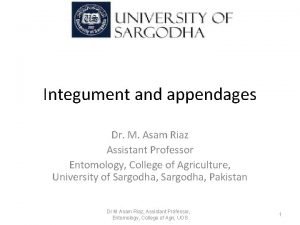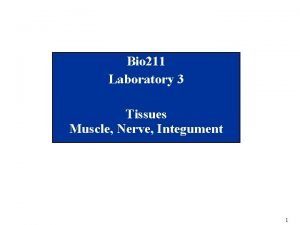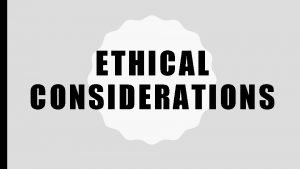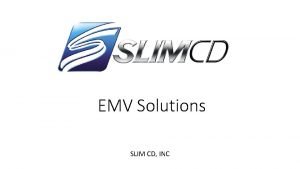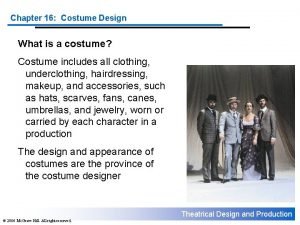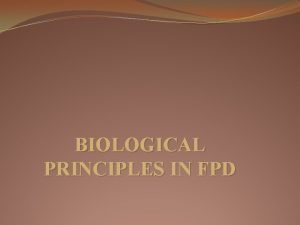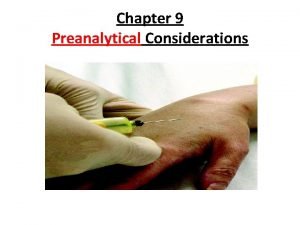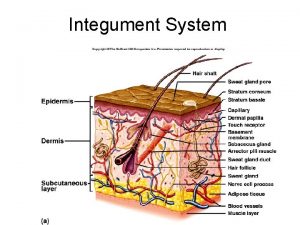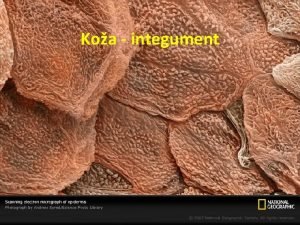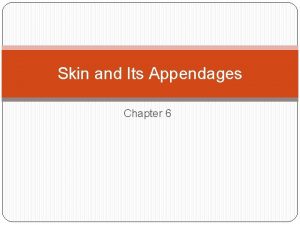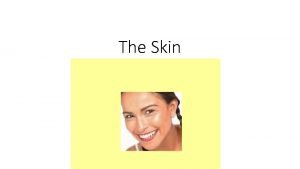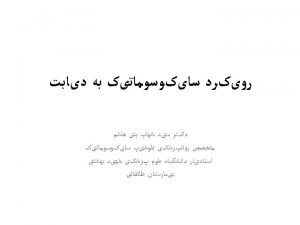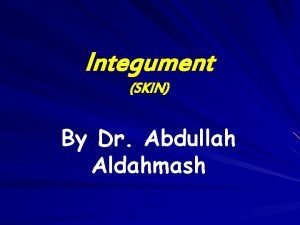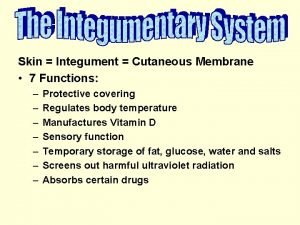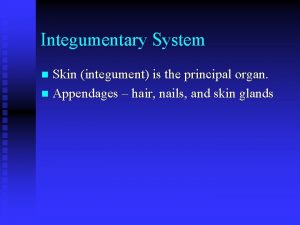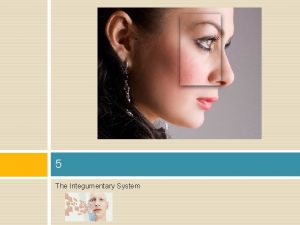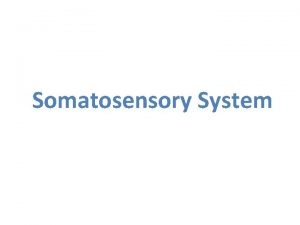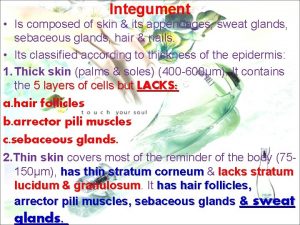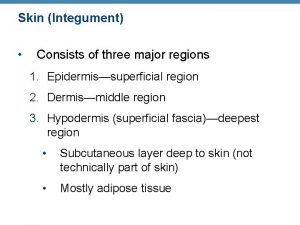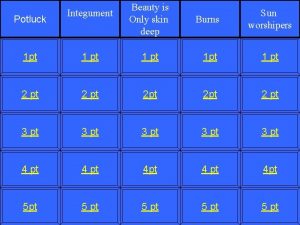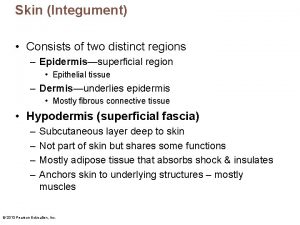INTEGUMENT SKIN I Skin General considerations A Skin


































- Slides: 34

INTEGUMENT - SKIN

I. Skin - General considerations: A. Skin is an organ that fulfills and/or mediates many different functions. (i. e. excretion, temperature control, communication with external environment, insulation, protection from abrasion and some dissolved substances, retards dehydration. ) Some people also find other uses for it. B. It is the largest/heaviest single organ in body (16% body wt. ). C. Consists of two major tissue layers 1. epidermis (ectoderm) - stratified squamous epithelium 2. dermis (mesoderm) - connective tissue http: //www. vh. org/Providers/Textbooks/Microscopic. Anatomy/Section 07/Plate 07135. html

D. Thickness and some aspects of the structure of these layers varies according to whether we are dealing with thick or thin skin. 1. Most of the body is covered with thin skin. http: //www. leeds. ac. uk/chb/pcd 1855/img 0020. jpg 2. Parts of the body that are subject to frequent abrasion such as the palms of the hands and soles of the feet are covered with thick skin. http: //www. udel. edu/Biology/Wags/ histopage/colorpage/cin. htm

E. Where epidermis and dermis meet, both are thrown into a series of folds that interdigitate. 1. The dermal folds are called dermal papillae. 2. Epidermal folds are called epidermal ridges. F. We can also consider a third layer that is not actually part of the skin, but that binds dermis to underlying or subjacent tissues. This is the subcutaneous layer or hypodermis. http: //www. lab. anhb. uwa. edu. au/mb 140/ http: //www. medinfo. ufl. edu/year 1/histo/images/h 9 h. jpg

STRUCTURE AND FUNCTION OF SKIN LAYERS I. Epidermis: A. There are 4 cell types 1. Keratinocytes 2. Melanocytes 3. Langerhans cells 4. Merkel cells http: //medic. med. uth. tmc. edu/slnkimg/00000057. gif

KERATINOCYTES B. First and most abundant cell type - cells of stratified squamous keratinized epithelium. 1. The cells of this epithelium become keratinized and are called keratinocytes. 2. They form a protective outer layer that is continuously shed and replaced from below. http: //www. leeds. ac. uk/chb/pcd 1855/img 0018. jpg

3. The epidermis (keratinized stratified squamous epithelium) can be divided into a series of sub-layers. Sub-layers of the epidermis. Starting at the surface. a. Stratum corneum b. Stratum lucidum c. Stratum granulosum d. Stratum spinosum e. Stratum basale = stratum germinativum f. In thick skin such as palms of hands and soles of feet, all layers can be easily identified. In thin skin that covers rest of body the stratum lucidum is not always apparent. http: //www. lab. anhb. uwa. edu. au/mb 140/

4. Stratum basale = stratum germinativum a. A basophilic, low columnar layer of cells (one cell thick) which lies on basement membrane that attaches it to the underlying dermis. b. Desmosomes bind the lateral and upper surfaces of these cells so they adhere strongly to each other. c. Hemi-desmosomes are found in the basal cell membranes and are involved in binding cells to the basal lamina. e. There is lots of mitosis occurring in this layer since it is responsible for providing cells to replace those shed as the upper layer of keratinocytes is worn away. f. These cells, and particularly they’re progeny, synthesize keratin that is stored as intermediate filaments in their cytoplasm. http: //www. lab. anhb. uwa. edu. au/mb 140/

5. Stratum spinosum a. Comprises the largest portion of living cells in the epidermis. b. Cell shape varies - consists of cuboidal, polygonal, or slightly flattened cells which have a plasmalemma that is thrown into a series of many short processes. c. These processes are filled with intermediate filaments and terminate with desmosomes formed between processes of adjacent cells. d. The processes of these cells give them a spiny appearance when viewed with the light microscope. Thus the name "spinosum". Also sometimes called the "prickly" layer. http: //www. meddean. luc. edu/lumen/Med. Ed/medicine/dermatology/skinlsn /stspin. htm http: //www. vh. org/Providers/Textbooks/Microscopic. Anatomy/ Section 07/Plate 07137. html http: //www. lab. anhb. uwa. edu. au/mb 140/ http: //education. vetmed. vt. edu/Curriculum/VM 8054/Labs/Lab 14/EXAMPLES/Exspinos. htm

Psoriasis= skin disorder where excessive cell division leads to increased thickening of stratum basale and spinosum http: //www. med. uiuc. edu/histo/large/atlas/image/tem 40/2750 a 1. htm d. These tightly bound processes are thought to impart resistance to abrasion to the epidermis. This is supported by the fact that the stratum spinosum is thicker in portions of skin subject to frequent abrasion such as palms and soles. e. The basal portion of the spinosum, next to the stratum basale (germinativum), contains additional mitosing cells. This germinative area is called the MALPIGHIAN LAYER.

6. Stratum granulosum a. This layer may be difficult to discern in thin skin b. It consists of 3 -5 layers of flattened polygonal cells that are characterized by two types of granules. * keratohyalin granules - contain histidine rich protein. No membrane around these granules. http: //www. lab. anhb. uwa. edu. au/mb 140/

* Membrane-coating lamellar granules (lamellar granules) ** These granules are formed by the golgi bodies and are membrane bound. **They move to the plasmalemma closest to the external environment and are exocytosed into the intercellular space. **The contents of these granules are glycosaminoglycans and phospholipids. **These substances help to cement cells together and also act as a barrier to penetration of the skin by foreign materials. (i. e. they seal the skin and decrease its permeability - helps prevent dehydration). ** First appeared in reptiles, not found in amphibians. The evolutionary development of the stratum granulosum was a critical event that allowed the evolution of fully terrestrial life forms. http: //www. lab. anhb. uwa. edu. au/mb 140/

7. Stratum lucidum a. This layer is most apparent in thick skin. May not be apparent in thin skin. b. Transition region between living and dead cells. It consists of a thin layer of extremely flattened cells. c. Organelles and nuclei are no longer evident in the cytoplasm. d. The cytoplasm is rich in densely packed keratin filaments in an electron-dense matrix called eleidin. http: //www. lab. anhb. uwa. edu. au/mb 140/

8. Stratum corneum a. This is the outermost layer of the skin. b. Consists of flattened, dead, non-nucleated, keratinized cells. c. The cytoplasm of these cells is filled with keratin filaments embedded in matrix. d. These keratinized cells are called horny cells. e. The stratum corneum is very thick in areas subject to frequent abrasion such as the palms and soles (e. g. 3 mm on soles). In thin skin, this layer is relatively thin and delicate. http: //www. lab. anhb. uwa. edu. au/mb 140/

9. Since the upper layer of skin is heavily keratinized and the lower layer (stratum germinativum) is not, it is clear that as cells of the epidermis progress toward the external surface, one of the things that is happening is that higher and higher concentrations of keratin are being synthesized and deposited in their cytoplasm. 10. Also, since cells of the stratum corneum lack organelles, something is occurring to rid the cells of these structures. a. So, what we find is that as keratinization proceeds, more and more autophagosomes and other lysosomes are present in the cytoplasm of epidermal cells. b. The autophagosomes are responsible for ridding the cytoplasm of organelles. Other lysosomes provide the enzymes necessary to digest these organelles. http: //www. vh. org/Providers/Textbooks/Microscopic. Anatomy/ Section 07/Plate 07136. html

C. Second skin cell type - Melanocytes pigment producing cells 1. Melanocytes are derived from neural crest cells (which you'll recall are also involved in the formation of the adrenyl medulla and tooth dentin). 2. Cell bodies of melanocytes are found between or beneath those of the stratum basale and stratum spinosum. 3. They extend cytoplasmic processes between cells of these two layers. These processes end in invaginations of the cells that comprise the stratum spinosum and stratum basale. 4. Melanin is synthesized by melanocytes via the action of an enzyme called tyrosinase on the amino acid tyrosine. http: //www. leeds. ac. uk/chb/pcd 1855/img 0020. jpg http: //www. leeds. ac. uk/chb/pcd 1855/img 0023. jpg

5. Melanin synthesis occurs in vesicles formed by the Golgi body and consists of 4 stages. a. Tyrosinase precursors are synthesized on ribosomes of the endoplasmic reticulum and accumulate in vesicles formed by the Golgi body. * Stage I vesicle - slight tyrosinase activity, so either the golgi packaged precursor is undergoing further processing, or tyrosinase in being added to Golgi vesicles as these vesicles fuse with each other. * Stage II vesicle - vesicle contains intermediate filaments which melanin is deposited on. * Stage III vesicle - concentration of melanin increases obscuring the filaments. * Stage IV vesicle - mature melanin granule, no filaments visible.

6. The melanin vesicles are transported into the processes of the melanocytes and are transferred to epidermal cells in the stratum basale (germinativum) and stratum spinosum.

7. Pigmentation of the skin is due to accumulations of melanin in epidermal cells (keratinocytes) rather the number of melanocytes present in the epidermis. 8. Thus, differences in skin color in people of the same race and of different races are due mainly to differences in the concentration of melanin granules in epidermal keratinocytes, not to differences in the number of melanocytes present. 9. As skin cells mature and become keratinized, melanin is enzymatically broken down such that dead cells of the stratum corneum have lost their pigmentation by time they are shed.

D. Third skin cell type - Langerhans cells 1. These cells are a specialized type of macrophage found in the stratum spinosum 2. Also called histiocytes 3. Recent evidence indicates that these cells "entrap" foreign antigens that enter the skin. Acts as an antigen presenting cell. 4. Defining characteristic - Rod (racket) shaped granules called Birbeck granules are present in cytoplasm. http: //med-ed. med. virginia. edu/med-ed/histology/imagedisplay. cfm? file=cell 0509 http: //sprojects. mmi. mcgill. ca/dermatology/immunology. htm#Langerhans http: //zappa. ultrakohl. com/Wsit 97/Aug 97/aug 97 p 4. htm

E. Fourth type of skin cell - Merkel cells 1. Present in hair follicles, thick skin of palms and soles, and oral mucosa. 2. Large, oval, poorly stained 3. Unmyelinated axons penetrate the stratum basale and terminate as expanded disks on the base of Merkel cells - may function in sensing both touch and pressure. 4. Membrane bound granules resembling neurosecretory vesicles suggest a possible hormonal function for these cells. http: //cs. swau. edu/~durkin/biol 101/lecture 27/notes. html

II. Dermis A. This is the connective tissue that supports epidermis and binds it to subjacent tissue B. The dermis is composed of two layers: 1. Papillary layer - thin 2. Reticular layer - thick

C. Papillary layer 1. Composed of loose connective tissue, mostly fibroblasts, but also mast cells, macrophages, and extravasated leukocytes. 2. This portion of the dermis interdigitates with the epidermis forming folds of the dermis that are called dermal papillae. a. Most papillae contain a capillary bed that provides nutrients to overlying and surrounding cells. b. Some papillae are "tactile papillae" and house sensory structures for touch called Meissner's corpuscles. * stacks of fibroblasts or modified Schwann cells with unmyelinated axons zig-zagging between them (the axons lose their myelin sheaths as they enter the corpuscle) http: //www. udel. edu/Biology/Wags/ http: //medocs. ucdavis. edu/CHA/402/studyset/lab 10/slide 15. htm histopage/colorpage/cintsmc 2. gif

3. From the papillary layer, collagen fibrils penetrate the dermal papillae and insert into the basal lamina of the epidermis, just beneath the stratum basale/germinativum. a. This binds the two layers together. b. The collagen fibrils are called anchoring fibrils. D. Reticular layer 1. This layer is thicker than the papillary layer and is composed of dense irregular connective tissue that contains collagen and elastic fibers. a. Fibers are the major component. b. There is a lower cell density in the reticular layer than the papillary layer. http: //www. lab. anhb. uwa. edu. au/mb 140/

2. Elastic fibers emerge from this layer and penetrate the papillary layer. a. As is the case with the anchoring fibers mentioned above, the ends of the elastic fibers penetrate the papillary layer and insert in the basal lamina below the stratum basale (germinativum). b. This elastic network is responsible for the elasticity of the skin. http: //www. lab. anhb. uwa. edu. au/mb 140/ 3. The functional cells of hair follicles, sweat glands, and oil glands are found in the reticular layer of the dermis.

4. Pacinian corpuscles may be found in the reticular layer. a. Sensory structures for pressure and possibly vibration. b. Consist of concentric layers (lamellae) composed of collagenous fibers with fibroblasts in between. c. An axon extends centrally into this onion like arrangement. d. The axon is unmyelinated within the corpuscle. e. Thick dense connective tissue sheath encloses the corpuscle. E. While the epidermis contains no blood or lymph vessels, the dermis contains many.

IV. Underlying the skin (epidermis + dermis) is a fatty, loose connective tissue layer called the hypodermis. This layer is not considered part of the skin! http: //www. meddean. luc. edu/lumen/Med. Ed/Histo. Images/hl 6 -11. jpg

V. Appendages of the skin A. There a number of structures that can be defined as appendages of the skin: 1. Hair/hair follicle 2. Finger and toe nails 3. Sebaceous glands 4. Sweat glands

B. Hair follicles 1. The hair follicle, in a sense, is a deep invagination of the epidermis that involves the stratum basale and stratum spinosum (sort of like an extra long epidermal ridge specialized for hair production). It penetrates into the reticular layer of the dermis and “pushes” a portion of this layer into the hypodermis. 2. The hair itself is essentially a specialized form of the keratinized layers of the epidermis. http: //www. lab. anhb. uwa. edu. au/mb 140/

3. The hair follicle extends deep into the reticular layer of the dermis and terminates at a vascularized "dermal papilla". * Note that this dermal papilla is close to the base of the reticular layer and, in that sense, is different from the "dermal papilla" that forms as an interdigitation with the epidermis in the papillary layer of the dermis. * The basal region of the follicle, including the dermal papilla, is called the bulb. * The epidermal cells covering the dermal papilla in the lower half of the bulb are called matrix cells and are responsible for producing the shaft of the hair. http: //www. lab. anhb. uwa. edu. au/mb 140/

2. The hair shaft itself, consists of 3 regions, a. The Medulla * 2 -3 layers of vacuolated cuboidal cells * present near base of hair, doe not extend through entire shaft b. The Cortex * several layers of elongated, heavily keratinized cells. * Melanin is sequestered between or within these cells * These cells become more flattened as you move toward the tip of the hair.

c. The Hair Cuticle * a layer of clear, flat, anucleate (dead) cells * these cells overlap one and other in a scale like fashion

3. The root of the follicle is surrounded by an inner sheath consisting of 3 layers. These are, a. The innermost layer (innermost cuticle) * Flat overlapping cells adjacent to the cuticle of the hair shaft * The edges of the cells of the innermost layer interdigitate with those of the hair cuticle forming a robust bond between the hair and the follicle wall. b. Huxley's layer - the middle layer * Several layers of elongated cells * Contain trichohyalin granules (a type of kerotohyalin granule) c. Henle's layer - the outermost layer * Single layer of flat, clear cells that are highly keratinized.

4. Henle's layer is surrounded by the outer (or external) root sheath. * This is continuous with the stratum spinosum and stratum basale * A thin, hyalin, modified basement membrane called the glassy membrane, surrounds the outer root sheath * Outside the glassy membrane is a poorly defined, connective tissue investment. http: //www. udel. edu/Biology/Wags/histopage/colorpage/cinhsl 1. gif http: //www. udel. edu/Biology/Wags/histopage/colorpage/cinhft 3. GIF READ ABOUT HAIR GROWTH, SWEAT GLANDS, AND SEBACEOUS GLANDS IN YOUR TEXT.
 What are the general considerations in machine design
What are the general considerations in machine design Integument
Integument Dr. asam
Dr. asam Cells in stratum spinosum
Cells in stratum spinosum Bio 211
Bio 211 Integument medical term
Integument medical term Integumentary system adalah
Integumentary system adalah Stratum basale
Stratum basale Bioreactor considerations for animal cell culture
Bioreactor considerations for animal cell culture Moral consideration in ethics
Moral consideration in ethics Atm kiosk solution
Atm kiosk solution Non rebreather mask nursing considerations
Non rebreather mask nursing considerations Slim cd inc
Slim cd inc Biopharmaceutic considerations in drug product design
Biopharmaceutic considerations in drug product design Eswl anesthesia considerations
Eswl anesthesia considerations Contrasting acquisition
Contrasting acquisition Practical considerations for costume design might include
Practical considerations for costume design might include Convection pdhpe
Convection pdhpe Collaboration design considerations
Collaboration design considerations Azure landing zone considerations
Azure landing zone considerations Design considerations for mobile computing
Design considerations for mobile computing Exchange transaction and relationship in marketing
Exchange transaction and relationship in marketing Ethical considerations examples
Ethical considerations examples Retro mylohyoid curtain
Retro mylohyoid curtain Writing strategies and ethical considerations
Writing strategies and ethical considerations Dissect the broad area into sub-areas
Dissect the broad area into sub-areas Pricing considerations and approaches
Pricing considerations and approaches What is cloud delivery model
What is cloud delivery model Gastrectomy anesthesia considerations
Gastrectomy anesthesia considerations Biological principles of cavity preparation
Biological principles of cavity preparation Data warehouse considerations
Data warehouse considerations Mechanical considerations of transmission line
Mechanical considerations of transmission line Consideration examples
Consideration examples Dogso spa
Dogso spa Basal state blood collection
Basal state blood collection


